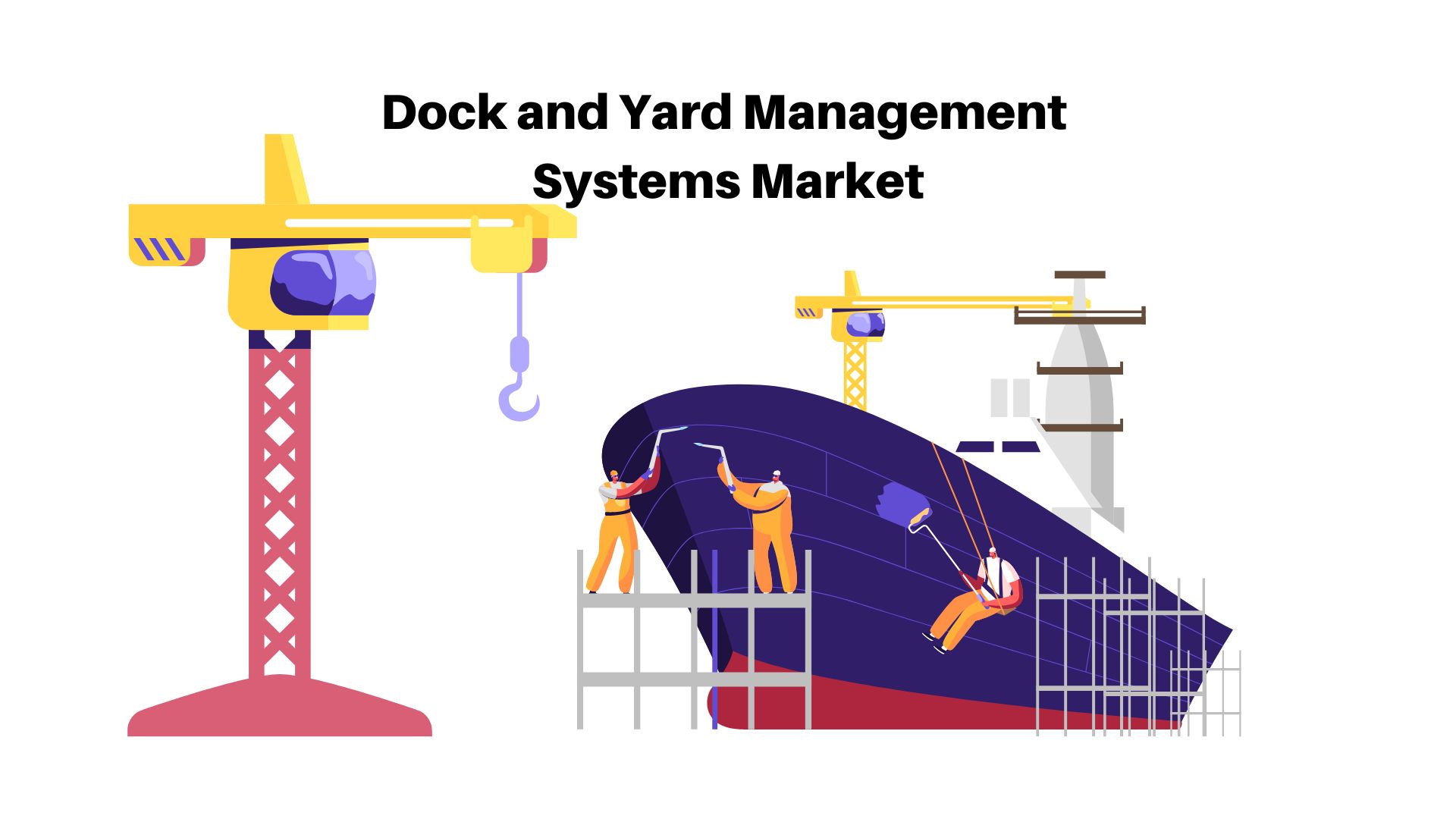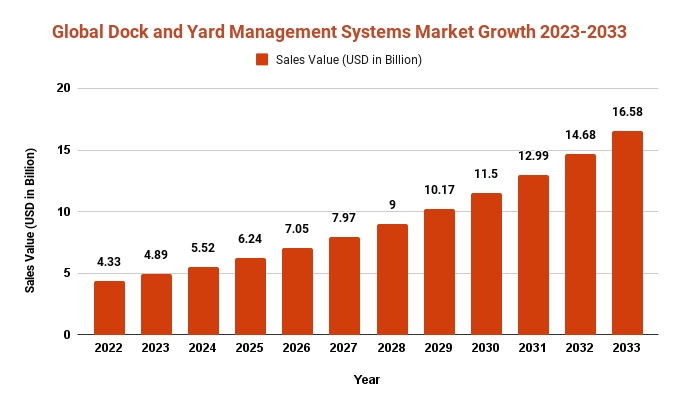Dock and Yard Management Systems Market will anticipate around USD 16.58 Bn by 2033

Page Contents
Market Overview
Published Via 11Press: Dock and yard management systems are software applications designed to assist companies manage the flow of goods through distribution centers, warehouses, and other facilities. These programs automate processes related to scheduling, tracking, and coordinating inbound/outbound shipments as well as maintaining storage areas, loading docks, and other key resources.
The Global Dock and Yard Management Systems market represented USD 4.33 Bn in 2022 and will anticipate around USD 16.58 Bn by 2033 projected around CAGR of 12.99% amid forecast frame of 2023 to 2033.
Some of the key features of dock and yard management systems may include:
- Appointment Scheduling: This feature allows shippers and carriers to plan pick-up and delivery appointments ahead of time, cutting down on wait times and improving efficiency.
- Dock management: This feature monitors the availability of loading and unloading docks, as well as the status of shipments in progress. This helps optimize dock resources and minimize delays.
- Yard Management: This feature monitors the location and status of trailers, containers, and other assets in your yard as well as their contents. Yard Management Software helps guarantee that the correct goods are delivered to the right location at precisely the right time.
- Inventory management: This feature helps monitor the movement of goods and materials within a warehouse, distribution center, or other facility from receipt to shipment. Doing so can reduce inventory costs, prevent stockouts, and enhance order accuracy.
- Reporting and Analytics: This feature offers managers real-time data on key performance indicators (KPIs) like order accuracy, on-time delivery rates, and inventory turnover. This can enable them to recognize trends, make informed decisions, and optimize operations over time.

Key Takeaways
- Dock and yard management systems are software programs designed to assist companies in controlling the flow of goods and materials through their facilities.
- These systems automate processes related to scheduling, tracking and coordinating inbound and outbound shipments as well as managing storage areas, loading docks and other key resources.
- Dock and yard management systems typically include appointment scheduling, dock management, yard management, inventory control, reporting, and analytics.
- These systems can assist companies in streamlining their logistics operations, cutting costs, and increasing efficiency.
- Dock and yard management systems can be especially beneficial for companies with extensive supply chains, where managing the flow of goods and materials can present a substantial obstacle.
Get Dock and Yard Management Systems Sample Report: https://marketresearch.biz/report/dock-and-yard-management-systems-market/request-sample/
Regional Snapshot
Dock and yard management systems are indispensable in streamlining the movement of goods and materials through ports, warehouses, and distribution centers. These systems offer real-time insight into inventory levels, shipments, and personnel numbers; enabling managers to optimize operations while cutting costs.
Here is a regional snapshot of dock and yard management systems:
- North America:
The North American market for dock and yard management systems is highly competitive, with several established players providing a range of solutions. This market is being driven by the expansion of e-commerce and logistics businesses which require efficient supply chain management solutions. Furthermore, advanced technologies such as RFID, GPS, and AI are driving this growth trend further. - Europe:
The European market for dock and yard management systems is mature, although adoption varies across different countries. The UK and Germany lead the region with increasing e-commerce activity driving demand. Furthermore, an increasing focus on sustainability and reducing carbon footprint in logistics operations are driving growth within this sector. - Asia-Pacific:
The Asia-Pacific market for dock and yard management systems is expanding rapidly, driven by the expansion of manufacturing, retail, and e-commerce businesses across the region. China and India are the two largest markets with several local players offering cost-effective solutions. Furthermore, advanced technologies such as AI and automation are propelling this sector's expansion. - Middle East and Africa:
The Middle East and Africa market for dock and yard management systems is small but growing, driven by the expansion of logistics and transportation industries in the region. Although adoption of these systems is still in its early stages, an increasing focus on efficiency and cost reduction in supply chain operations is fueling market expansion.
Inquire with our industry specialist: https://marketresearch.biz/report/dock-and-yard-management-systems-market/#inquiry
Drivers
Dock and yard management systems (DYMS) are driven by several factors that make them indispensable in streamlining material flows within ports, warehouses, and distribution centers. Here are some of DYMS' primary driving forces:
- DYMS addresses the growing need for real-time visibility and control: By providing up-to-the minute data on inventory, shipments, and personnel with DYMS, managers can optimize operations while cutting costs. The rising need for this level of supply chain visibility is driving the adoption of DYMS software solutions.
- Growth of E-commerce and Online Retail: With the expansion of e-commerce and online retail, there has been an uptick in the volume of goods being transported. Therefore, supply chain operations need to be optimized. Dynamic warehouse management software (DYMS) helps streamline this flow while decreasing delivery times and costs.
- Advancements in Technology: The adoption of advanced technologies like RFID, GPS and AI is propelling the growth of DYMS. These systems enable real-time tracking and monitoring of goods and materials to reduce the risk of loss or damage.
- Sustainability Initiatives: There is an ever-increasing emphasis on sustainability and reducing carbon footprint in logistics operations. DYMS help optimize transportation routes, cutting fuel consumption and emissions.
- Cost reduction and Efficiency: DYMS assists supply chain operations to cut costs and boost efficiency. By optimizing the flow of goods and materials, DYMS reduces delivery times, boosts productivity levels, and enhances inventory management.
- Government Regulations: Governments are increasingly introducing regulations to enhance supply chain operations, such as safety and emissions reduction. DYMS helps companies abide by these requirements, decreasing the likelihood of penalties or fines.
Restraints
- High implementation costs: The initial investment required to implement DYMS can be significant, including the costs of hardware, software, and integration with existing systems. This can be a major barrier to adoption, particularly for small and medium-sized enterprises.
- Resistance to change: The implementation of DYMS may require changes in processes and workflows, which may be met with resistance from employees. This resistance can impact the effectiveness of the system and may require additional training and support to overcome.
- Integration challenges: Integration with existing systems can be complex, particularly in cases where legacy systems are in place. This can impact the effectiveness of the system and may require additional resources and expertise to overcome.
- Cybersecurity risks: DYMS involve the use of sensitive data, including inventory, shipment, and personnel information. This data is vulnerable to cybersecurity threats, including hacking, data breaches, and ransomware attacks. This can lead to significant financial and reputational damage to organizations that use DYMS.
- Lack of standardization: The lack of standardization in DYMS can make it difficult to compare and evaluate different solutions. This can make it difficult for organizations to make informed decisions about which systems to implement.
- Infrastructure limitations: DYMS may require significant infrastructure upgrades, including new hardware and network infrastructure. In some cases, these upgrades may not be feasible due to limitations in existing infrastructure.
Opportunities
Dock and Yard Management Systems (DYMS) give businesses real-time visibility and control of the entire supply chain process, from dock to yard. As e-commerce and just-in-time delivery models have grown increasingly popular, DYMS has become more indispensable than ever for businesses looking to optimize their warehouse operations and reduce costs.
Companies have many opportunities to enhance their DYMS, such as:
- Integration with Other Systems: Companies can enhance their DYMS by connecting it to other software programs, such as transportation management systems (TMS) or warehouse management systems (WMS). Doing so will simplify processes and give a comprehensive view of the supply chain overall.
- Utilization of RFID Technology: Radio-frequency identification (RFID) technology can simplify tracking and tracing shipments, saving time on manual data entry tasks while improving accuracy.
- Real-Time Analytics: Employing real-time analytics allows companies to gain valuable insights into their DYMS performance, including metrics such as dock and yard utilization rates, shipment lead times, and inventory levels.
- Automation of Tasks: Automation of mundane activities such as yard checks and dock scheduling can enhance efficiency while decreasing the potential for errors.
- Cloud-Based DYMS: Cloud-based DYMS can give businesses greater flexibility and scalability, enabling them to quickly adjust according to changing business demands.
- Integration with Autonomous Vehicles: Connecting DYMS to autonomous vehicles such as self-driving trucks can help optimize yard operations and eliminate manual labor requirements.
Challenges
- Implementing a DYMS can be expensive, as it may necessitate extensive investments in technology and infrastructure. Employees may feel uneasy with the idea of making drastic changes and are unwilling to adopt new technology or processes, which could hinder the implementation of a DYMS. DYMS depend on accurate data input to operate efficiently and effectively, so any inaccurate or incomplete information could lead to errors and inefficiencies. Integrating a DYMS with other systems, such as transportation management systems (TMS) or warehouse management systems (WMS), can be both complex and time-consuming.
- DYMS stores sensitive data such as shipment details and inventory levels, making them vulnerable to cyber attacks. Maintaining and upgrading a Dynamic Inventory Management System can be complex, as it may necessitate regular software upgrades as well as hardware upkeep. DYMS must be capable of scaling to meet the changing demands of a business, something which may prove challenging without significant investments in technology and infrastructure.
Market Segmentation
Type
- Warehouse Management Systems WMS
- Transportation Management Systems TMS
Application
- Transportation & Logistics
- Manufacturing
- Grocery
- Retailing and Parcel Post
- Others
Key Players
- 4sight Solutions
- Descartes Systems Group Inc
- C3 Solutions
- Epicor Software Corporation
- Descartes Systems Group Inc.
- Epicor Software Corp.
- HighJump Software, Inc.
- Made4net LLC
- Lazer Spot, Inc.
- Manhattan Associates, Inc.
- Oracle Corporation
- ProAct International Ltd.
- Royal 4 Systems
- Softeon Inc.
- Zebra Technologies Corporation
Report Scope
| Report Attribute | Details |
| Market size value in 2022 | USD 4.33 Bn |
| Revenue forecast by 2033 | USD 16.58 Bn |
| Growth Rate | CAGR Of 12.99% |
| Regions Covered | North America, Europe, Asia Pacific, Latin America, and Middle East & Africa, and Rest of the World |
| Historical Years | 2017-2022 |
| Base Year | 2022 |
| Estimated Year | 2023 |
| Short-Term Projection Year | 2028 |
| Long-Term Projected Year | 2033 |
Growing Demand => Request for Customization
Recent Developments
Dock and Yard Management Systems (DYMS) have seen dramatic advancements in recent years due to technological advancements and emerging trends. Some of the most noteworthy recent updates include:
- Internet of Things (IoT) Integration: DYMS are increasingly being integrated with IoT sensors to provide real-time data on equipment, shipments and inventory levels. This enables businesses to optimize operations and swiftly adjust according to changes in the supply chain.
- Artificial Intelligence (AI) and Machine Learning (ML): AI and ML are being employed to enhance Dynamics by Management System (DYMS) through predictive analytics, automated scheduling, and optimized resource allocation. This has the potential to reduce costs and boost efficiency at the same time.
- Cloud-Based Systems: DYMS are increasingly being provided as cloud-based solutions, giving businesses greater adaptability and scalability while eliminating the need for on-premise infrastructure.
- Mobile Applications: Mobile applications are being created to offer real-time updates on DYMS operations, allowing businesses to monitor and manage their supply chains from anywhere.
- Automated Yard Management: Advanced yard management systems are being created that utilize robotics and automation to boost efficiency and cut labor costs.
- Integration with Autonomous Vehicles: DYMS are being integrated with autonomous vehicles, such as self-driving trucks, to enhance yard operations and reduce manual labor requirements.
Key Questions
What is Dock and Yard Management System (DYMS)?
A Dock and Yard Management System is a software solution designed to assist businesses manage the flow of goods between warehouses, distribution centers, and manufacturing plants. DYMS typically includes functionalities like dock scheduling, yard management, inventory tracking, and shipment tracking.
What are the Advantages of Implementing a DYMS?
Implementing a DYMS can help businesses optimize their supply chain operations, reduce expenses and boost efficiency. Benefits such as increased visibility into inventory and shipment movements, streamlined processes, reduced wait times and improved labor utilization can all be realized through this system.
What are the key challenges associated with implementing a DYMS?
Implementation of a DYMS often faces high costs, resistance from employees to change, data accuracy issues, integration difficulties, security threats, maintenance/updates and scalability concerns.
How does DYMS integrate with other systems such as Transportation Management Systems (TMS) and Warehouse Management Systems (WMS)?
DYMS can be integrated with TMS and WMS to give a comprehensive view of the supply chain process. Doing so can streamline procedures, eliminate manual data entry, and offer real-time visibility into goods movement.
What are some recent developments in DYMS?
Recent advancements within DYMS include IoT integration, AI/ML capabilities, cloud-based solutions, mobile applications for automated yard management and integration with autonomous vehicles. These improvements have the potential to significantly enhance supply chain operations, reduce costs and boost efficiency.
Contact us
Contact Person: Mr. Lawrence John
Marketresearch.Biz (Powered By Prudour Pvt. Ltd.)
Tel: +1 (347) 796-4335
Send Email: [email protected]
The team behind market.us, marketresearch.biz, market.biz and more. Our purpose is to keep our customers ahead of the game with regard to the markets. They may fluctuate up or down, but we will help you to stay ahead of the curve in these market fluctuations. Our consistent growth and ability to deliver in-depth analyses and market insight has engaged genuine market players. They have faith in us to offer the data and information they require to make balanced and decisive marketing decisions.



